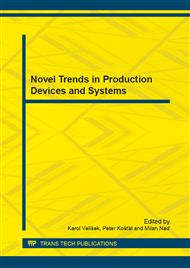p.357
p.363
p.369
p.375
p.381
p.387
p.393
p.399
p.405
The Mechanical Characteristics of 3D Printed Parts According to the Build Orientation
Abstract:
This article is focused on a production of mechanically resistant physical models using Rapid Prototyping technology. There are two tested materials, ABS is the first build material and ABS-like is the second build material with similar properties. The article describes the production of a testing component - element for tensile tests by two RP technologies. The first technology is FDM (Fused Deposition Modeling) and the second PolyJet Matrix. Further the article describes the description and evaluation of the tensile tests.
Info:
Periodical:
Pages:
381-386
Citation:
Online since:
January 2014
Authors:
Keywords:
Price:
Сopyright:
© 2014 Trans Tech Publications Ltd. All Rights Reserved
Share:
Citation:


